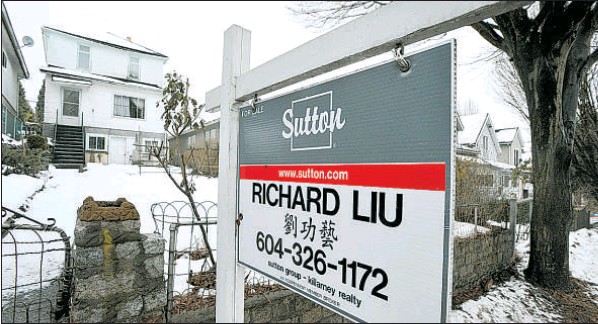But the bottom appears closer as asset selling seems to be subsiding
Eric Beauchesne
Province

’The housing slump ain’t over yet,’ says BMO Capital Markets Jennifer Lee.
The mood in Canada‘s business community is the darkest it has been since 9/11.
That comes amid an avalanche of bad economic news, which persisted yesterday with reports of further reversals in commodity prices and more grim news from the United States — Canada‘s main export market — of plunging home sales, falling orders for durable goods and rising unemployment claims.
The Conference Board of Canada reported that its January survey of businesses found their level of confidence continued to slide through the final quarter of last year and into this year, the sixth-straight quarterly decline and to the lowest point since 2001.
The think-tank’s index of business confidence tumbled another 9.1 points to 68.9 points at the start of the first quarter, nearly 38 points down from its peak in the second quarter of 2007.
Only twice in the past — the third quarter of 2001 and during the 1990-91 recession — has the mood been darker, and in those cases, the drop in confidence preceded a contraction in business capital investment, which does not bode well for the economy, the think-tank noted.
“The latest survey . . . indicates that this pattern is set to repeat itself in 2009,” the board said.
“Faced with a progressively grimmer economic outlook, firms are significantly curtailing their investment intentions.”
The survey, however, preceded this week’s federal budget, which promises to inject $40 billion in stimulus into the economy over the coming two years, including measures to ease the credit crunch, which the board’s survey found is a major impediment to production.
But the economic news was not reassuring.
“The North American economic storm continues to roll across the continent, leaving a flood of soft economic data in its wake,” noted Mark Frey, vice-president foreign-exchange trading at Custom House, a Canadian international payments firm. Durable-goods orders in the U.S. “fell off a cliff” while continuing jobless claims increased, reflecting the persistent weakness in that job market, he noted.
Further, new-home sales south of the border plunged 14.7 per cent from November, way beyond the 2.5 per cent markets expected, leaving sales down nearly 50 per cent from a year earlier and at their lowest level on records going back before the early 1980s.
“The housing slump ain’t over yet,” observed BMO Capital Markets economist Jennifer Lee, noting that the inability to sell new homes is despite an environment of 30-year high affordability and falling mortgage rates.
And there was further evidence of global and domestic economic weakness in the Canadian economic reports.
Scotiabank, in reporting another steep fall this month in its commodity price index, noted that the “shift from ‘boom to bust’ in many commodities has been the most rapid in the history of the . . . index.
“For the fifth consecutive month, Scotiabank’s commodity price index . . . posted another sharp decline in December, falling 5.5 per cent month-over-month,” it said, noting that left the index down 39 per cent from its July peak.
However, there were signs that the bottom is getting closer.
“While commodity prices are not yet at a bottom, the pace of decline is now slowing and the forced, indiscriminate asset selling by funds appears to be subsiding,” said Scotiabank economist and commodity market specialist Patricia Mohr.
© Copyright (c) The Province
